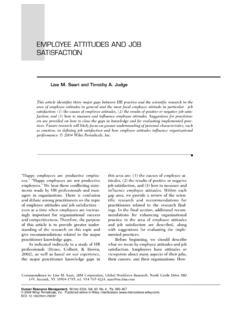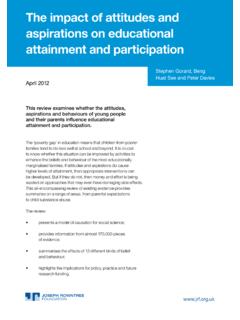Transcription of Measuring Violence-Related Attitudes, Behaviors, and ...
1 Measuring violence -RelatedAttitudes, Behaviors, and InfluencesAmong Youths:A Compendium of Assessment ToolsSecond EditionNDEPARTTOFHEALTH&HUMANSERVICEUSAD EPARTMETOFHEALTH&HUMANSERVICESUSAThis compendium of assessment tools is a publication of theNational Center for Injury Prevention and Control of theCenters for Disease Control and for Disease Control and PreventionJulie L. Gerberding, MD, MPH, DirectorNational Center for Injury Prevention and ControlIleana Arias, PhD, Acting DirectorDivision of violence PreventionW. Rodney Hammond, PhD, DirectorGraphic Design and Layout:Jeffrey C. JusticeCover Design:Jeffrey C. JusticeCover Photography:Kid s World, James Carroll Artville, LLC, 1997 Suggested Citation: Dahlberg LL, Toal SB, Swahn M,Behrens CB. Measuring Violence-Related Attitudes, Behaviors, and Influences Among Youths: A Compendium ofAssessment Tools, 2nd ed.
2 , Atlanta, GA: Centers for DiseaseControl and Prevention, National Center for Injury Preventionand Control, violence -RelatedAttitudes, Behaviors, and Influences Among Youths:A Compendium of Assessment ToolsSecond EditionCompiled and Edited byLinda L. Dahlberg, PhDSusan B. Toal, MPHM onica H. Swahn, PhDChristopher B. Behrens, MDDivision of violence PreventionNational Center for Injury Prevention and ControlCenters for Disease Control and PreventionAtlanta, Georgia2005 AcknowledgmentsIn 1992 and 1993, the Centers forDisease Control and Prevention funded15 evaluation projects whose primarygoal was to identify interventions thatchange Violence-Related Attitudes, beliefs and behaviors among childrenand youths. The investigators andprogram staff from these projects madeinvaluable contributions to the field ofviolence prevention and wereinstrumental to the development of thefirst edition of this compendiumpublished in 1998.
3 Since that time,additional studies have been completedwhich serve to further enrich our abilityto evaluate outcomes of violenceprevention efforts. There have also beena number of longitudinal studiesconducted over the last two decades thathave greatly enhanced ourunderstanding of the factors thatincrease and decrease the risk for youthviolence. We wish to acknowledge andthank all individuals who havecontributed measures to thiscompendium and who have helped tomove the field of violence Lawrence AberMichael W. ArthurHenry (Hank) AthaKris BosworthRichard CatalanoJohn CoieEdward DeVosKenneth DodgeDennis D. EmbryLeonard EronDorothy EspelageAlbert D. FarrellDavid P. FarringtonDaniel J. FlanneryRobert L. FlewellingVangie A. FosheeRoy M. GabrielDeborah Gorman-SmithNancy G.
4 GuerraMarshall HaskinsJ. David HawkinsDavid HenryTony HopsonArthur (Andy) M. HorneCynthia HudleyL. Rowell HuesmannKenneth W. JacksonRussell H. JacksonSteven H. KelderMarvin D. Krohn Molly LairdGerry LandsbergJennifer LansfordLinda Lausell-BryantFletcher LinderAlan J. LizotteRolf LoeberChristopher MaxwellAleta L. MeyerHelen NadelPamela OrpinasMallie J. PaschallPam K. PorterDavid L. RabinerChristopher L. RingwaltTom RoderickFaith SamplesRobert J. SampsonMichael SchoenyJohn SlavikMark SpellmannCarolyn A. Smith David A. StoneMagda Stouthamer-LoeberTerence P. Thornberry Patrick TolanRick VanAckerWelmoet B. Van KammenAlexander T. VazsonyiWilliam H. WiistContentsAcknowledgments ..iiHow To Use This Compendium ..1 How This Compendium Is OrganizedChoosing the Right InstrumentIntroduction.
5 5 Why Outcome Evaluations Are So ImportantComponents of Comprehensive EvaluationsTen Steps for Conducting Outcome EvaluationsFuture ConsiderationsSection IAttitude and Belief Assessments ..13 Section IIPsychosocial and Cognitive Assessments ..61 Section IIIB ehavior Assessments ..161 Section IVEnvironmental Assessments ..275 Index ..360iiiThis compendium provides researchers andprevention specialists with a set of tools to assessviolence- related beliefs, behaviors, and influences,as well as to evaluate programs to prevent youthviolence. If you are new to the field of youthviolence prevention and unfamiliar with availablemeasures, you may find this compendium to beparticularly useful. If you are an experiencedresearcher, this compendium may serve as aresource to identify additional measures to assess thefactors associated with violence among this compendium contains more than170 measures, it is not an exhaustive listing ofavailable measures.
6 A few of the more widely usedmeasures to assess aggression in children, forexample, are copyrighted and could not be includedhere. Other measures being used in the field, but notknown to the authors, are also not included. Many ofthe measures included in the first edition of thecompendium focused on individual violence -relatedattitudes, beliefs, and behaviors. These types ofmeasures are included in this edition as well and maybe particularly useful if you are evaluating a school-based curriculum or a community-based programdesigned to reduce violence among youths. Severalmeasures to assess peer, family, and communityinfluences have been added to the of these measures are from the majorlongitudinal and prevention research studies of youthviolence being conducted in the United States.
7 Most of the measures in this compendium areintended for use with youths between the ages of 11and 24 years, to assess such factors as seriousviolent and delinquent behavior , conflict resolutionstrategies, social and emotional competencies, peerinfluences, parental monitoring and supervision,family relationships, exposure to violence , collectiveefficacy, and neighborhood characteristics. Thecompendium also contains a number of scales andassessments developed for use with childrenbetween the ages of 5 and 10 years, to measurefactors such as aggressive fantasies, beliefssupportive of aggression, attributional biases,prosocial behavior , and aggressive behavior . Whenparent and teacher versions of assessments areavailable, they are included as This Compendium Is OrganizedThe Introduction, beginning on page 5, providesinformation about why outcome evaluations are soimportant and includes some guidance on how toconduct such evaluations.
8 Following theIntroduction, you will find four sections, eachfocusing on a different category of section contains the following components: Description of Measures. This tablesummarizes key information about all of theassessments included in the section. Eachassessment is given an alphanumeric identifier( , A1, A2, A3) that is used repeatedlythroughout the section, to guide you throughthe array of assessments provided. The tableidentifies the constructs being measured(appearing in alphabetical order down the left-hand column), provides details about thecharacteristics of the scale or assessment,identifies target groups that the assessment hasbeen tested with, provides reliability andvalidity information where known, andidentifies the persons responsible fordeveloping the scale or assessment.
9 Whenreviewing the Ta rget Group information, keepin mind that we have included only those1 How To Use This Compendiumtarget groups we know and that the reliabilityinformation pertains specifically to thesegroups and may not apply to other reviewing the Reliability/Validityinformation, you will notice that severalmeasures are highly reliable ( , internalconsistency >.80) whereas others areminimally reliable ( , internal consistency < .60). We included measures with minimalreliability because the reliability informationis based, in some cases, on only one targetgroup from one study; these measures may bemore appropriate for a different target also included measures with limitedreliability with the hope that researchers willtry to improve and refine them. Evidence ofvalidity is available for only a few of themeasures included in this compendium.
10 Scales and Assessments. The items thatmake up each assessment are provided,along with response categories and someguidance to assist you with scoring andanalysis. In the few instances where scaleshave been adapted, the most recent(modified) version is presented. We alsohave provided information on how to obtainpermission to use copyrighted materials. Inmost cases, we have presented individualscales rather than the complete instrumentsbecause instruments generally are composedof several scales. This approach increasesthe likelihood that the scales test propertieswill be altered. Nonetheless, we did thisbecause the field has produced fewstandardized instruments with establishedpopulation norms for a range of targetaudiences. References. This list includes citations forpublished and unpublished materials pertainingto original developments as well as any recentadaptations, modifications, or validations.

















